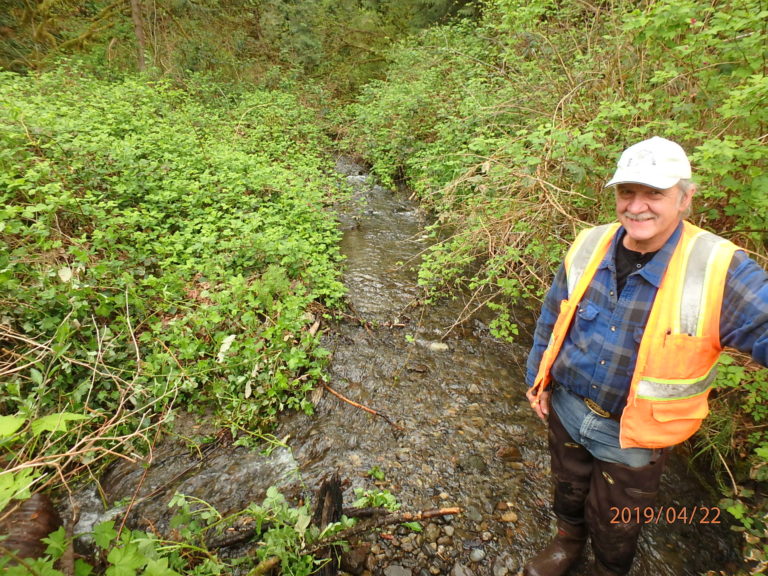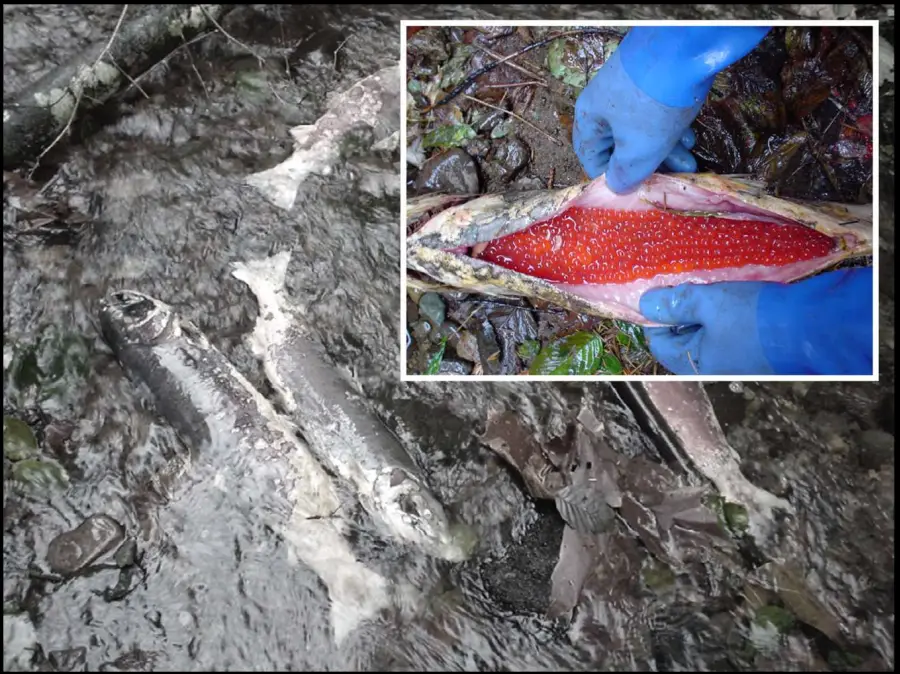

Pre-spawn mortality (PSM) and high egg retention (HER) are an emerging toxicity issue impacting Puget Sound watersheds. Where it occurs, adult salmon returning to freshwater die before they are able to spawn completely. The cause of PSM and HER was identified as toxic road runoff associated with chemicals leaching out of automobile ‘tire dust’ which wears off tires during the normal wear and tear of driving.
Wild Fish Conservancy completed weekly spawning surveys of channels in Snohomish County, northwest Washington State, with annual fall coho runs of 10 or more individuals and which represent a range in road density and stormwater inputs.
During the course of the survey, the riparian area was carefully inspected for signs of carcasses dragged to shore by animals such as otters, dogs, raccoons, bears, opossums and coyotes. Crews were also vigilant for the wafting odor of a rotting carcass, prompting a heightened search in those areas.
Spawning success was determined by examining female carcass gonads. The eggs of females are contained within two separate skeins within the body cavity. If these skeins appeared equal in size, full, firm, and intact, the fish was considered un-spawned. If eggs were retained by the fish, they were counted. When counting was impractical, the volume of eggs retained was measured in a beaker, and the diameter of five randomly chosen eggs was measured to estimate the average egg diameter. With these two values the estimated number of eggs in the fish could be calculated. If 100% of the eggs were retained the fish exhibited PSM and if the fish retained 10-99% of their eggs they exhibited HER. Neither the spawning success of males or spawning success of significantly scavenged fish were included in analysis because they were either too difficult or too subjective to evaluate in the field.
While no statistical relationship was found between the percentage of female carcasses with pre-spawn mortality and the land use of the location where the fish was found, the majority of the land use in sites sampled had a low percentage of development (0-9%) and 12% of all the fish sampled exhibited pre-spawn mortality, or high egg retention at death. It is recommended that this study be carried out again at locations with different trends in land use and more ranges in percent developed.
Location | Start Date |
|---|---|
29 index reaches, Snohomish watershed, Northwest Washington State | 10/28/2003 |
Project Type | Completion Date |
|---|---|
Spawning Survey | 02/12/2004 |
To identify occurrences of pre-spawn mortality and high egg retention in coho populations.
To identify the relationship between land use and occurrences of both pre-spawn mortality and high egg retention.
To use this information to help in identifying and prioritizing locations where improving stormwater infrastructure will prevent continual damage to biota in streams.
Primary Habitats Impacted By Project: | Managing Agency/ Organization: |
|---|---|
Rural and Urban Riparian Stream Channels | Wild Fish Conservancy |
Project Contact: | Budget or Project Cost: |
|---|---|
Jamie Glasgow |
Funding Sources: | Partners: |
|---|---|
NOAA Fisheries, WDFW, Washington Department of Ecology, Snohomish County Surface Water Management, King County Water Pollution Control Division |
Join our mailing list to recieve important updates on our work, the latest wild fish news, & opportunities to take action to support wild fish.
This site is protected by reCAPTCHA and the Google Privacy Policy and Terms of Service apply.
Wild Fish Conservancy is recognized as a 501(c)3 non-profit by the IRS